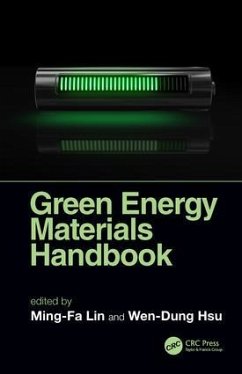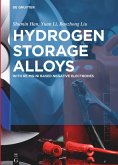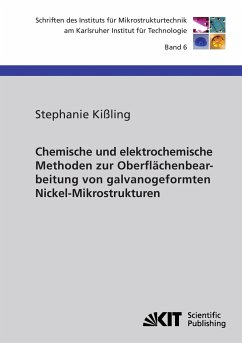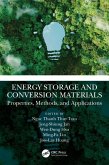Green Energy Materials Handbook
Herausgeber: Lin, Ming-Fa; Hsu, Wen-Dung
Green Energy Materials Handbook
Herausgeber: Lin, Ming-Fa; Hsu, Wen-Dung
- Gebundenes Buch
- Merkliste
- Auf die Merkliste
- Bewerten Bewerten
- Teilen
- Produkt teilen
- Produkterinnerung
- Produkterinnerung
This book provides a systematic review of the development of reliable, low-cost, and high-performance green energy materials, covering both up-to-date mainstream computational and experimental studies. It presents reliable and complete experimental measurements and computational results as well as potential applications.
Andere Kunden interessierten sich auch für
![Glass-Ceramic Technology Glass-Ceramic Technology]() Wolfram HolandGlass-Ceramic Technology214,99 €
Wolfram HolandGlass-Ceramic Technology214,99 €![Hydrogen Storage Alloys Hydrogen Storage Alloys]() Shumin HanHydrogen Storage Alloys111,99 €
Shumin HanHydrogen Storage Alloys111,99 €![Co-Crystals Co-Crystals]() Co-Crystals233,99 €
Co-Crystals233,99 €![Chemische und elektrochemische Methoden zur Oberflächenbearbeitung von galvanogeformten Nickel-Mikrostrukturen Chemische und elektrochemische Methoden zur Oberflächenbearbeitung von galvanogeformten Nickel-Mikrostrukturen]() Stephanie KißlingChemische und elektrochemische Methoden zur Oberflächenbearbeitung von galvanogeformten Nickel-Mikrostrukturen30,50 €
Stephanie KißlingChemische und elektrochemische Methoden zur Oberflächenbearbeitung von galvanogeformten Nickel-Mikrostrukturen30,50 €![Energy Storage and Conversion Materials Energy Storage and Conversion Materials]() Energy Storage and Conversion Materials196,99 €
Energy Storage and Conversion Materials196,99 €![Porous Carbon Materials for Clean Energy Porous Carbon Materials for Clean Energy]() Porous Carbon Materials for Clean Energy196,99 €
Porous Carbon Materials for Clean Energy196,99 €![Handbook of Sustainable Materials Handbook of Sustainable Materials]() Handbook of Sustainable Materials207,99 €
Handbook of Sustainable Materials207,99 €-
-
-
This book provides a systematic review of the development of reliable, low-cost, and high-performance green energy materials, covering both up-to-date mainstream computational and experimental studies. It presents reliable and complete experimental measurements and computational results as well as potential applications.
Hinweis: Dieser Artikel kann nur an eine deutsche Lieferadresse ausgeliefert werden.
Hinweis: Dieser Artikel kann nur an eine deutsche Lieferadresse ausgeliefert werden.
Produktdetails
- Produktdetails
- Verlag: CRC Press
- Seitenzahl: 384
- Erscheinungstermin: 3. Juli 2019
- Englisch
- Abmessung: 240mm x 161mm x 25mm
- Gewicht: 740g
- ISBN-13: 9781138605916
- ISBN-10: 1138605913
- Artikelnr.: 57012188
- Herstellerkennzeichnung
- Libri GmbH
- Europaallee 1
- 36244 Bad Hersfeld
- gpsr@libri.de
- Verlag: CRC Press
- Seitenzahl: 384
- Erscheinungstermin: 3. Juli 2019
- Englisch
- Abmessung: 240mm x 161mm x 25mm
- Gewicht: 740g
- ISBN-13: 9781138605916
- ISBN-10: 1138605913
- Artikelnr.: 57012188
- Herstellerkennzeichnung
- Libri GmbH
- Europaallee 1
- 36244 Bad Hersfeld
- gpsr@libri.de
Ming-Fa Lin is a distinguished professor in the Department of Physics, National Cheng Kung University, Taiwan. He received his PhD in physics in 1993 from the National Tsing-Hua University, Taiwan. His main scientific interests focus on essential properties of carbon-related materials and low-dimensional systems. He is a member of American Physical Society, American Chemical Society, and Physical Society of Republic of China (Taiwan). Wen-Dung Su is Associate Professor, Department of Materials Science, National Cheng Kung University, Taiwan. Dr. Su received a PhD from University of Florida and was awarded Outstanding Teaching Award, Institute of Engineering Education, Taiwan.
1. Introduction
2. Molecular effects of functional polymer binders on Li+ transport on
the cathode surface within lithium ion battery
2.1 Introduction
2.2 Molecular dynamics simulation details
2.3 Results and discussion
2.4 Summary and future perspectives
3. Essential properties of Li/Li+ graphite intercalation compounds
3.1 Introduction
3.2 The theoretical model
3.3 Rich geometric structures of graphites and graphite intercalation
compounds
3.4 Unusual band structures of graphite-related systems
3.5 van Hove singularities in density of states
3.6 Chemical bondings and charge distributions
3.7 Summary
4. Defective and amorphous graphene as anode materials for Li-ion
batteries: a first-principles study
4.1 Introduction
4.2 Computational methods
4.3 Results and discussions
4.4 Conclusion
5. Rich Essential Properties of Si-Doped Graphene
5.1 Introduction
5.2 Computational methods
5.3 Geometric structures of Si-adsorbed and Si-substituted graphene
5.4 Rich electronic structures
5.5 Spatial charge densities
5.6 The diverse density of states
5.7 Summary
6. Diversified essential properties in transition metals adsorbed
Graphene
6.1 Introduction
6.2 The theoretical model
6.3 Results and discussions
6.4 Summary
7. Combining neural network with first-principles calculations for
computational screening of electrolyte additives in lithium ion
batteries
7.1 Introduction
7.2 Materials and methods
7.3 Results and disscussions
7.4 Conclusion
8. Metal oxide-reduced graphene oxide (MO-RGO) nanocomposite as high
performance anode materials in Lithium ion batteries
8.1 Introduction
8.2 Potential binary metal oxides asanode materials in LIBs
8.3 Complex metal oxides as anode materials in LIBs
8.4 Metal oxide-graphene/reduced graphene oxide nanocomposite as
anode materials in LIBs
8.5 Our research contribution toward LIB
8.6 Conclusions
9. In-situ X-ray and Neutron Analysis Techniques on Lithium/Sodium ion
batteries
9.1 Introduction
9.2 Methodology for in-situ X-ray and neutron scattering experiments
9.3 In-situ X-ray analysis on synergistic effects of Si anode
materials
9.4 In-operando X-ray diffraction - a quantitative analysis on
Si-graphite negative electrode
9.5 In-situ X-ray diffraction analysis of lithiation-induced crystal
restructuring of Sn/TiO2 nanocrystallites
9.6 In-operando neutron diffraction analysis on low temperature
lithium diffusion behaviors in 18650 Li-ion battery
9.7 In-operando neutron diffraction Studies on P2-Na2/3Fe1/3Mn2/3O2
cathode in a sodium ion battery
9.8 Summary
10. Micro-Phase Separated poly(VdF-co-HFP)/Ionic Liquid/Carbonate as Gel
Polymer Electrolytes for Lithium-Ion Batteries
10.1 Introduction
10.2 Experimental
10.3 Results and discussion
10.4 Conclusion
11. Gel and solid electrolytes for Lithium ion batteries
11.1 Introduction
11.2 Solid-state electrolytes (SSEs)
11.3 Gel Polymer Electrolytes (GPEs)
11.4 Summary
12. Silicon-Nanowire Based Hybrid Solar Cells
12.1 Introduction
12.2 Silicon nanowires fabrication
12.3 PEDOT: PSS polymer as the p-type layer of hybrid solar cell
application
12.4 Silicon Nanowire based Hybrid Solar Cells
12.5 Conclusion
13. Characterization and Performance of Li-ZnO Nanofiber and Nanoforest
Photoanodes for Dye-sensitized Solar Cell
13.1 Introduction
13.2 Experimental
13.3 Results and discussion
13.4 Conclusion
14. Review of monolithic dye-sensitized solar cells and perovskite solar
cells
14.1 Introduction
14.2 Monolithic dye-sensitized solar cells
1. Mesoporous electrode for monolithic perovskite solar cells
2. Conclusion
15. High-Performance Quasi-Solid-State Polymer Electrolytes for
Dye-Sensitized Solar Cell Applications
16. Concluding Remarks
17. Perspective on Battery Research
Index
2. Molecular effects of functional polymer binders on Li+ transport on
the cathode surface within lithium ion battery
2.1 Introduction
2.2 Molecular dynamics simulation details
2.3 Results and discussion
2.4 Summary and future perspectives
3. Essential properties of Li/Li+ graphite intercalation compounds
3.1 Introduction
3.2 The theoretical model
3.3 Rich geometric structures of graphites and graphite intercalation
compounds
3.4 Unusual band structures of graphite-related systems
3.5 van Hove singularities in density of states
3.6 Chemical bondings and charge distributions
3.7 Summary
4. Defective and amorphous graphene as anode materials for Li-ion
batteries: a first-principles study
4.1 Introduction
4.2 Computational methods
4.3 Results and discussions
4.4 Conclusion
5. Rich Essential Properties of Si-Doped Graphene
5.1 Introduction
5.2 Computational methods
5.3 Geometric structures of Si-adsorbed and Si-substituted graphene
5.4 Rich electronic structures
5.5 Spatial charge densities
5.6 The diverse density of states
5.7 Summary
6. Diversified essential properties in transition metals adsorbed
Graphene
6.1 Introduction
6.2 The theoretical model
6.3 Results and discussions
6.4 Summary
7. Combining neural network with first-principles calculations for
computational screening of electrolyte additives in lithium ion
batteries
7.1 Introduction
7.2 Materials and methods
7.3 Results and disscussions
7.4 Conclusion
8. Metal oxide-reduced graphene oxide (MO-RGO) nanocomposite as high
performance anode materials in Lithium ion batteries
8.1 Introduction
8.2 Potential binary metal oxides asanode materials in LIBs
8.3 Complex metal oxides as anode materials in LIBs
8.4 Metal oxide-graphene/reduced graphene oxide nanocomposite as
anode materials in LIBs
8.5 Our research contribution toward LIB
8.6 Conclusions
9. In-situ X-ray and Neutron Analysis Techniques on Lithium/Sodium ion
batteries
9.1 Introduction
9.2 Methodology for in-situ X-ray and neutron scattering experiments
9.3 In-situ X-ray analysis on synergistic effects of Si anode
materials
9.4 In-operando X-ray diffraction - a quantitative analysis on
Si-graphite negative electrode
9.5 In-situ X-ray diffraction analysis of lithiation-induced crystal
restructuring of Sn/TiO2 nanocrystallites
9.6 In-operando neutron diffraction analysis on low temperature
lithium diffusion behaviors in 18650 Li-ion battery
9.7 In-operando neutron diffraction Studies on P2-Na2/3Fe1/3Mn2/3O2
cathode in a sodium ion battery
9.8 Summary
10. Micro-Phase Separated poly(VdF-co-HFP)/Ionic Liquid/Carbonate as Gel
Polymer Electrolytes for Lithium-Ion Batteries
10.1 Introduction
10.2 Experimental
10.3 Results and discussion
10.4 Conclusion
11. Gel and solid electrolytes for Lithium ion batteries
11.1 Introduction
11.2 Solid-state electrolytes (SSEs)
11.3 Gel Polymer Electrolytes (GPEs)
11.4 Summary
12. Silicon-Nanowire Based Hybrid Solar Cells
12.1 Introduction
12.2 Silicon nanowires fabrication
12.3 PEDOT: PSS polymer as the p-type layer of hybrid solar cell
application
12.4 Silicon Nanowire based Hybrid Solar Cells
12.5 Conclusion
13. Characterization and Performance of Li-ZnO Nanofiber and Nanoforest
Photoanodes for Dye-sensitized Solar Cell
13.1 Introduction
13.2 Experimental
13.3 Results and discussion
13.4 Conclusion
14. Review of monolithic dye-sensitized solar cells and perovskite solar
cells
14.1 Introduction
14.2 Monolithic dye-sensitized solar cells
1. Mesoporous electrode for monolithic perovskite solar cells
2. Conclusion
15. High-Performance Quasi-Solid-State Polymer Electrolytes for
Dye-Sensitized Solar Cell Applications
16. Concluding Remarks
17. Perspective on Battery Research
Index
1. Introduction
2. Molecular effects of functional polymer binders on Li+ transport on
the cathode surface within lithium ion battery
2.1 Introduction
2.2 Molecular dynamics simulation details
2.3 Results and discussion
2.4 Summary and future perspectives
3. Essential properties of Li/Li+ graphite intercalation compounds
3.1 Introduction
3.2 The theoretical model
3.3 Rich geometric structures of graphites and graphite intercalation
compounds
3.4 Unusual band structures of graphite-related systems
3.5 van Hove singularities in density of states
3.6 Chemical bondings and charge distributions
3.7 Summary
4. Defective and amorphous graphene as anode materials for Li-ion
batteries: a first-principles study
4.1 Introduction
4.2 Computational methods
4.3 Results and discussions
4.4 Conclusion
5. Rich Essential Properties of Si-Doped Graphene
5.1 Introduction
5.2 Computational methods
5.3 Geometric structures of Si-adsorbed and Si-substituted graphene
5.4 Rich electronic structures
5.5 Spatial charge densities
5.6 The diverse density of states
5.7 Summary
6. Diversified essential properties in transition metals adsorbed
Graphene
6.1 Introduction
6.2 The theoretical model
6.3 Results and discussions
6.4 Summary
7. Combining neural network with first-principles calculations for
computational screening of electrolyte additives in lithium ion
batteries
7.1 Introduction
7.2 Materials and methods
7.3 Results and disscussions
7.4 Conclusion
8. Metal oxide-reduced graphene oxide (MO-RGO) nanocomposite as high
performance anode materials in Lithium ion batteries
8.1 Introduction
8.2 Potential binary metal oxides asanode materials in LIBs
8.3 Complex metal oxides as anode materials in LIBs
8.4 Metal oxide-graphene/reduced graphene oxide nanocomposite as
anode materials in LIBs
8.5 Our research contribution toward LIB
8.6 Conclusions
9. In-situ X-ray and Neutron Analysis Techniques on Lithium/Sodium ion
batteries
9.1 Introduction
9.2 Methodology for in-situ X-ray and neutron scattering experiments
9.3 In-situ X-ray analysis on synergistic effects of Si anode
materials
9.4 In-operando X-ray diffraction - a quantitative analysis on
Si-graphite negative electrode
9.5 In-situ X-ray diffraction analysis of lithiation-induced crystal
restructuring of Sn/TiO2 nanocrystallites
9.6 In-operando neutron diffraction analysis on low temperature
lithium diffusion behaviors in 18650 Li-ion battery
9.7 In-operando neutron diffraction Studies on P2-Na2/3Fe1/3Mn2/3O2
cathode in a sodium ion battery
9.8 Summary
10. Micro-Phase Separated poly(VdF-co-HFP)/Ionic Liquid/Carbonate as Gel
Polymer Electrolytes for Lithium-Ion Batteries
10.1 Introduction
10.2 Experimental
10.3 Results and discussion
10.4 Conclusion
11. Gel and solid electrolytes for Lithium ion batteries
11.1 Introduction
11.2 Solid-state electrolytes (SSEs)
11.3 Gel Polymer Electrolytes (GPEs)
11.4 Summary
12. Silicon-Nanowire Based Hybrid Solar Cells
12.1 Introduction
12.2 Silicon nanowires fabrication
12.3 PEDOT: PSS polymer as the p-type layer of hybrid solar cell
application
12.4 Silicon Nanowire based Hybrid Solar Cells
12.5 Conclusion
13. Characterization and Performance of Li-ZnO Nanofiber and Nanoforest
Photoanodes for Dye-sensitized Solar Cell
13.1 Introduction
13.2 Experimental
13.3 Results and discussion
13.4 Conclusion
14. Review of monolithic dye-sensitized solar cells and perovskite solar
cells
14.1 Introduction
14.2 Monolithic dye-sensitized solar cells
1. Mesoporous electrode for monolithic perovskite solar cells
2. Conclusion
15. High-Performance Quasi-Solid-State Polymer Electrolytes for
Dye-Sensitized Solar Cell Applications
16. Concluding Remarks
17. Perspective on Battery Research
Index
2. Molecular effects of functional polymer binders on Li+ transport on
the cathode surface within lithium ion battery
2.1 Introduction
2.2 Molecular dynamics simulation details
2.3 Results and discussion
2.4 Summary and future perspectives
3. Essential properties of Li/Li+ graphite intercalation compounds
3.1 Introduction
3.2 The theoretical model
3.3 Rich geometric structures of graphites and graphite intercalation
compounds
3.4 Unusual band structures of graphite-related systems
3.5 van Hove singularities in density of states
3.6 Chemical bondings and charge distributions
3.7 Summary
4. Defective and amorphous graphene as anode materials for Li-ion
batteries: a first-principles study
4.1 Introduction
4.2 Computational methods
4.3 Results and discussions
4.4 Conclusion
5. Rich Essential Properties of Si-Doped Graphene
5.1 Introduction
5.2 Computational methods
5.3 Geometric structures of Si-adsorbed and Si-substituted graphene
5.4 Rich electronic structures
5.5 Spatial charge densities
5.6 The diverse density of states
5.7 Summary
6. Diversified essential properties in transition metals adsorbed
Graphene
6.1 Introduction
6.2 The theoretical model
6.3 Results and discussions
6.4 Summary
7. Combining neural network with first-principles calculations for
computational screening of electrolyte additives in lithium ion
batteries
7.1 Introduction
7.2 Materials and methods
7.3 Results and disscussions
7.4 Conclusion
8. Metal oxide-reduced graphene oxide (MO-RGO) nanocomposite as high
performance anode materials in Lithium ion batteries
8.1 Introduction
8.2 Potential binary metal oxides asanode materials in LIBs
8.3 Complex metal oxides as anode materials in LIBs
8.4 Metal oxide-graphene/reduced graphene oxide nanocomposite as
anode materials in LIBs
8.5 Our research contribution toward LIB
8.6 Conclusions
9. In-situ X-ray and Neutron Analysis Techniques on Lithium/Sodium ion
batteries
9.1 Introduction
9.2 Methodology for in-situ X-ray and neutron scattering experiments
9.3 In-situ X-ray analysis on synergistic effects of Si anode
materials
9.4 In-operando X-ray diffraction - a quantitative analysis on
Si-graphite negative electrode
9.5 In-situ X-ray diffraction analysis of lithiation-induced crystal
restructuring of Sn/TiO2 nanocrystallites
9.6 In-operando neutron diffraction analysis on low temperature
lithium diffusion behaviors in 18650 Li-ion battery
9.7 In-operando neutron diffraction Studies on P2-Na2/3Fe1/3Mn2/3O2
cathode in a sodium ion battery
9.8 Summary
10. Micro-Phase Separated poly(VdF-co-HFP)/Ionic Liquid/Carbonate as Gel
Polymer Electrolytes for Lithium-Ion Batteries
10.1 Introduction
10.2 Experimental
10.3 Results and discussion
10.4 Conclusion
11. Gel and solid electrolytes for Lithium ion batteries
11.1 Introduction
11.2 Solid-state electrolytes (SSEs)
11.3 Gel Polymer Electrolytes (GPEs)
11.4 Summary
12. Silicon-Nanowire Based Hybrid Solar Cells
12.1 Introduction
12.2 Silicon nanowires fabrication
12.3 PEDOT: PSS polymer as the p-type layer of hybrid solar cell
application
12.4 Silicon Nanowire based Hybrid Solar Cells
12.5 Conclusion
13. Characterization and Performance of Li-ZnO Nanofiber and Nanoforest
Photoanodes for Dye-sensitized Solar Cell
13.1 Introduction
13.2 Experimental
13.3 Results and discussion
13.4 Conclusion
14. Review of monolithic dye-sensitized solar cells and perovskite solar
cells
14.1 Introduction
14.2 Monolithic dye-sensitized solar cells
1. Mesoporous electrode for monolithic perovskite solar cells
2. Conclusion
15. High-Performance Quasi-Solid-State Polymer Electrolytes for
Dye-Sensitized Solar Cell Applications
16. Concluding Remarks
17. Perspective on Battery Research
Index








